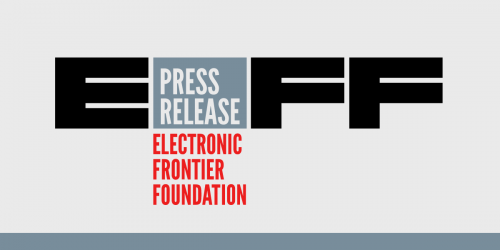SAN FRANCISCO – A new college journalism curriculum module teaches students how to protect themselves and their digital devices when working near and across the U.S.-Mexico border.
“Digital Security 101: Crossing the US-Mexico Border” was developed by Electronic Frontier Foundation (EFF) Director of Investigations Dave Maass and Dr. Martin Shelton, deputy director of digital security at Freedom of the Press Foundation (FPF), in collaboration with the University of Texas at El Paso (UTEP) Multimedia Journalism Program and Borderzine.
The module offers a step-by-step process for improving the digital security of journalists passing through U.S. Land Ports of Entry, focusing on threat modeling: thinking through what you want to protect, and what actions you can take to secure it.
This involves assessing risk according to the kind of work the journalist is doing, the journalist’s own immigration status, potential adversaries, and much more, as well as planning in advance for protecting oneself and one’s devices should the journalist face delay, detention, search, or device seizure. Such planning might include use of encrypted communications, disabling or enabling certain device settings, minimizing the data on devices, and mentally preparing oneself to interact with border authorities.
The module, in development since early 2023, is particularly timely given increasingly invasive questioning and searches at U.S. borders under the Trump Administration and the documented history of border authorities targeting journalists covering migrant caravans during the first Trump presidency.
"Today's journalism students are leaving school only to face complicated, new digital threats to press freedom that did not exist for previous generations. This is especially true for young reporters serving border communities," Shelton said. "Our curriculum is designed to equip emerging journalists with the skills to protect themselves and sources, while this new module is specifically tailored to empower students who must regularly traverse ports of entry at the U.S.-Mexico border while carrying their phones, laptops, and multimedia equipment."
The guidance was developed through field visits to six ports of entry across three border states, interviews with scores of journalists and students from on both sides of the border, and a comprehensive review of CBP policies, while also drawing from EFF and FPF’s combined decades of experience researching constitutional rights and security techniques when it comes to our devices.
“While this training should be helpful to investigative journalists from anywhere in the country who are visiting the borderlands, we put journalism students based in and serving border communities at the center of our work,” Maass said. “Whether you’re reviewing the food scene in San Diego and Tijuana, covering El Paso and Ciudad Juarez’s soccer teams, reporting on family separation in the Rio Grande Valley, or uncovering cross-border corruption, you will need the tools to protect your work and sources."
The module includes a comprehensive slide deck that journalism lecturers can use and remix for their classes, as well as an interactive worksheet. With undergraduate students in mind, the module includes activities such as roleplaying a primary inspection interview and analyzing pop singer Olivia Rodrigo’s harrowing experience of mistaken identity while reentering the country. The module has already been delivered successfully in trainings with journalism students at UTEP and San Diego State University.
“UTEP’s Multimedia Journalism program is well-situated to help develop this digital security training module,” said UTEP Communication Department Chair Dr. Richard Pineda. “Our proximity to the U.S.-Mexico border has influenced our teaching models, and our student population – often daily border crossers – give us a unique perspective from which to train journalists on issues related to reporting safely on both sides of the border.”
For the “Digital security 101: Crossing the US-Mexico border” module: https://freedom.press/digisec/blog/border-security-module/
For more about the module: https://www.eff.org/deeplinks/2025/06/journalist-security-checklist-preparing-devices-travel-through-us-border
For EFF’s guide to digital security at the U.S. border: https://www.eff.org/press/releases/digital-privacy-us-border-new-how-guide-eff
For EFF’s student journalist Surveillance Self Defense guide: https://ssd.eff.org/playlist/journalism-student












